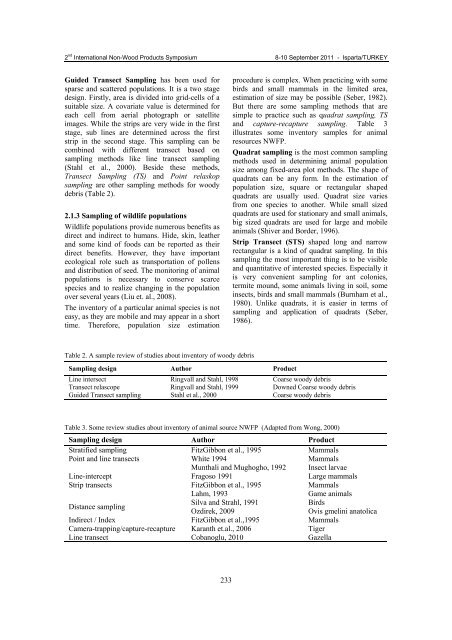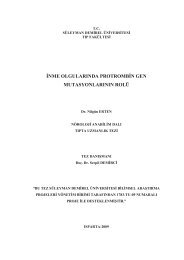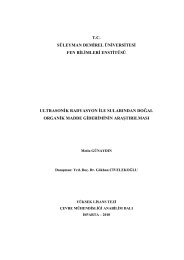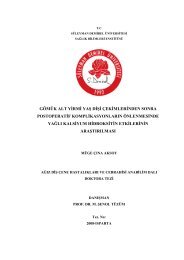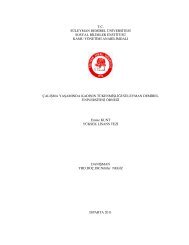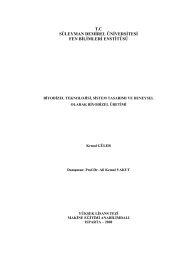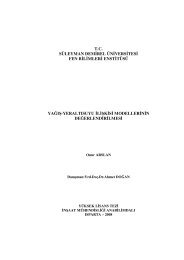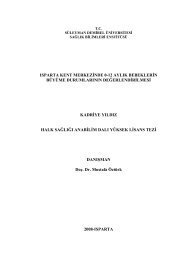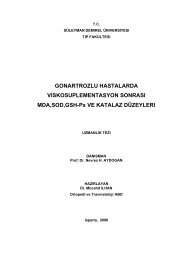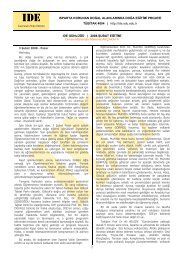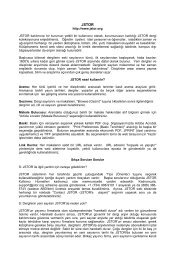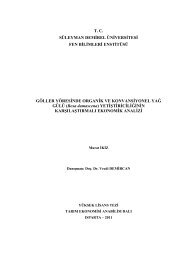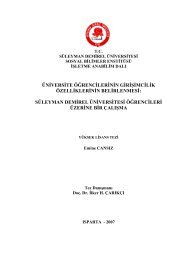Proceedings Book / Bildiri Kitabı - Orman Fakültesi - Süleyman ...
Proceedings Book / Bildiri Kitabı - Orman Fakültesi - Süleyman ...
Proceedings Book / Bildiri Kitabı - Orman Fakültesi - Süleyman ...
You also want an ePaper? Increase the reach of your titles
YUMPU automatically turns print PDFs into web optimized ePapers that Google loves.
2 nd International Non-Wood Products Symposium 8-10 September 2011 - Isparta/TURKEY<br />
Guided Transect Sampling has been used for<br />
sparse and scattered populations. It is a two stage<br />
design. Firstly, area is divided into grid-cells of a<br />
suitable size. A covariate value is determined for<br />
each cell from aerial photograph or satellite<br />
images. While the strips are very wide in the first<br />
stage, sub lines are determined across the first<br />
strip in the second stage. This sampling can be<br />
combined with different transect based on<br />
sampling methods like line transect sampling<br />
(Stahl et al., 2000). Beside these methods,<br />
Transect Sampling (TS) and Point relaskop<br />
sampling are other sampling methods for woody<br />
debris (Table 2).<br />
2.1.3 Sampling of wildlife populations<br />
Wildlife populations provide numerous benefits as<br />
direct and indirect to humans. Hide, skin, leather<br />
and some kind of foods can be reported as their<br />
direct benefits. However, they have important<br />
ecological role such as transportation of pollens<br />
and distribution of seed. The monitoring of animal<br />
populations is necessary to conserve scarce<br />
species and to realize changing in the population<br />
over several years (Liu et. al., 2008).<br />
The inventory of a particular animal species is not<br />
easy, as they are mobile and may appear in a short<br />
time. Therefore, population size estimation<br />
procedure is complex. When practicing with some<br />
birds and small mammals in the limited area,<br />
estimation of size may be possible (Seber, 1982).<br />
But there are some sampling methods that are<br />
simple to practice such as quadrat sampling, TS<br />
and capture-recapture sampling. Table 3<br />
illustrates some inventory samples for animal<br />
resources NWFP.<br />
Quadrat sampling is the most common sampling<br />
methods used in determining animal population<br />
size among fixed-area plot methods. The shape of<br />
quadrats can be any form. In the estimation of<br />
population size, square or rectangular shaped<br />
quadrats are usually used. Quadrat size varies<br />
from one species to another. While small sized<br />
quadrats are used for stationary and small animals,<br />
big sized quadrats are used for large and mobile<br />
animals (Shiver and Border, 1996).<br />
Strip Transect (STS) shaped long and narrow<br />
rectangular is a kind of quadrat sampling. In this<br />
sampling the most important thing is to be visible<br />
and quantitative of interested species. Especially it<br />
is very convenient sampling for ant colonies,<br />
termite mound, some animals living in soil, some<br />
insects, birds and small mammals (Burnham et al.,<br />
1980). Unlike quadrats, it is easier in terms of<br />
sampling and application of quadrats (Seber,<br />
1986).<br />
Table 2. A sample review of studies about inventory of woody debris<br />
Sampling design Author Product<br />
Line intersect Ringvall and Stahl, 1998 Coarse woody debris<br />
Transect relascope Ringvall and Stahl, 1999 Downed Coarse woody debris<br />
Guided Transect sampling Stahl et al., 2000 Coarse woody debris<br />
Table 3. Some review studies about inventory of animal source NWFP (Adapted from Wong, 2000)<br />
Sampling design Author Product<br />
Stratified sampling FitzGibbon et al., 1995 Mammals<br />
Point and line transects White 1994 Mammals<br />
Munthali and Mughogho, 1992 Insect larvae<br />
Line-intercept Fragoso 1991 Large mammals<br />
Strip transects FitzGibbon et al., 1995 Mammals<br />
Lahm, 1993<br />
Distance sampling<br />
Silva and Strahl, 1991<br />
Ozdirek, 2009<br />
Indirect / Index FitzGibbon et al.,1995 Mammals<br />
Camera-trapping/capture-recapture Karanth et.al., 2006 Tiger<br />
Line transect Cobanoglu, 2010 Gazella<br />
Game animals<br />
Birds<br />
Ovis gmelini anatolica<br />
233


